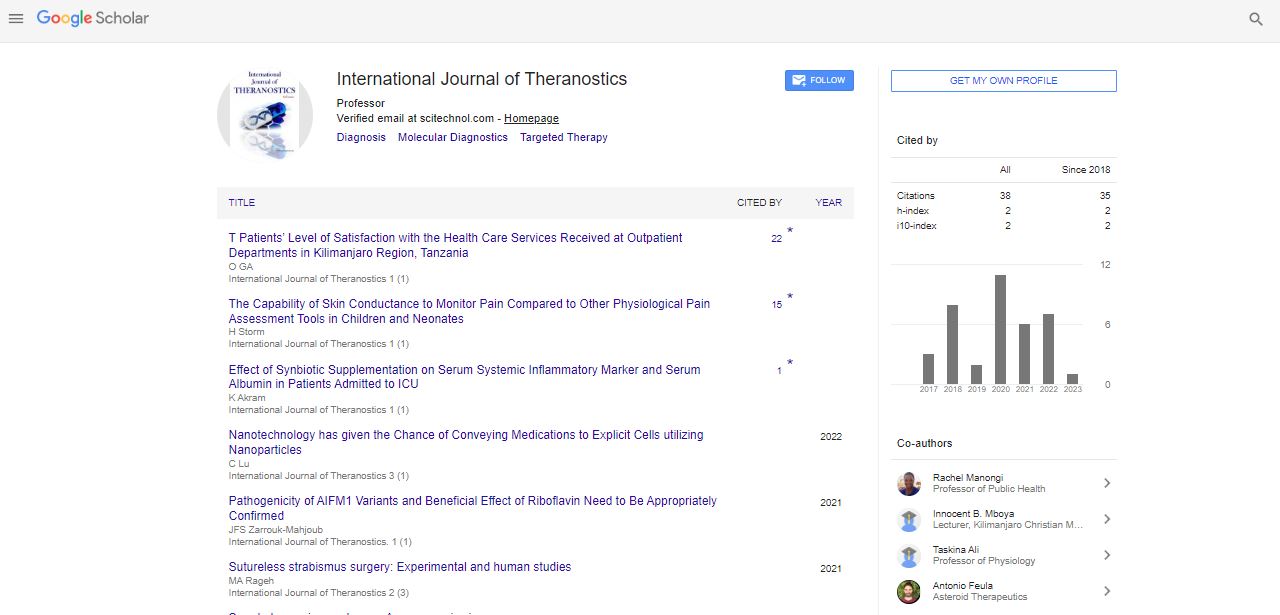Perspective, Ijt Vol: 12 Issue: 3
The Importance of Fluorodeoxyglucose F18 (FDG) in Medical Imaging
Isho Takamasa*
1Department of Surgery, Kindai University, Osaka, Japan
*Corresponding Author: Isho Takamasa,
Department of Surgery, Kindai
University, Osaka, Japan
E-mail: takaisho5@med.kindai.ac.jp
Received date: 30 August, 2023, Manuscript No. IJT-23-117612;
Editor assigned date: 01 September, 2023, PreQC No. IJT-23-117612 (PQ);
Reviewed date: 15 September, 2023, QC No. IJT-23-117612;
Revised date: 22 September, 2023, Manuscript No. IJT-23-117612 (R);
Published date: 02 October, 2023, DOI: 10.4172/IJT.1000136.
Citation: Takamasa I (2023) The Importance of Fluorodeoxyglucose F18 (FDG) in Medical Imaging. Int J Theranostic 12:3.
Abstract
In the realm of modern medical imaging, the use of radiopharmaceuticals has revolutionized our ability to diagnose and monitor various medical conditions. Among these powerful compounds, Fluorodeoxyglucose F18, often abbreviated as FDG, has emerged as a vital tool in the fields of nuclear medicine and Positron Emission Tomography (PET) imaging.
Description
In the realm of modern medical imaging, the use of radiopharmaceuticals has revolutionized our ability to diagnose and monitor various medical conditions. Among these powerful compounds, Fluorodeoxyglucose F18, often abbreviated as FDG, has emerged as a vital tool in the fields of nuclear medicine and Positron Emission Tomography (PET) imaging. This article delves into the world of FDG, exploring its properties, applications, and the invaluable insights it provides to healthcare professionals.
FDG
Fluorodeoxyglucose F18 is a radiopharmaceutical, a compound that contains a radioactive isotope of fluorine known as F18. The key to FDG's effectiveness lies in its close resemblance to regular glucose, which is the body's primary source of energy. Instead of stable carbon atoms, FDG contains F18, a radioactive form of fluorine. Because of this similarity to glucose, cells readily take up FDG, mistaking it for a usable energy source. This unique property forms the basis of FDG's role in medical imaging.
A patient receives an intravenous injection of FDG, allowing the radiopharmaceutical to circulate throughout the body. Cells with high metabolic activity, such as cancer cells, take up FDG at an increased rate compared to normal cells. This differential uptake forms the basis of PET imaging's diagnostic power. A PET scanner detects the radiation emitted by F18 and creates detailed images that reveal areas of increased metabolic activity. This is especially valuable in locating tumors, assessing their activity, and evaluating the stage of cancer.
Applications of FDG in medical imaging
FDG-PET imaging is widely used to identify and stage cancerous tumors throughout the body. It assists in detecting primary and metastatic tumors, determining their aggressiveness, and monitoring the response to cancer treatments. It is employed to study brain function and detect abnormalities. It helps in diagnosing conditions such as Alzheimer's disease, epilepsy, and brain tumors by mapping glucose metabolism in the brain. This can evaluate myocardial viability and assess the extent of damage following a heart attack. This is important for treatment planning and predicting patient outcomes. The increased metabolic activity in infected or inflamed tissues makes FDG-PET a valuable tool for identifying and localizing infections and inflammatory conditions. FDG-PET is also used to assess how well a patient is responding to cancer treatments, allowing healthcare providers to make timely adjustments to therapy.
FDG is a safe radiopharmaceutical when administered under appropriate medical supervision. Its short half-life (about 110 minutes) ensures that radiation exposure is minimized. Patients may need to follow certain precautions, such as fasting before the FDG-PET scan, to enhance the diagnostic accuracy of the procedure.
Conclusion
Fluorodeoxyglucose F18 (FDG) is a remarkable radiopharmaceutical that has transformed the landscape of medical imaging, particularly in the fields of oncology, neurology, and cardiology. By harnessing the body's metabolic processes and the unique properties of FDG, healthcare professionals gain profound insights into the functioning of various tissues, enabling early and accurate diagnoses. As technology continues to advance, FDG-based imaging techniques are likely to play an increasingly pivotal role in the diagnosis and treatment of a wide range of medical conditions. It is a testament to the power of innovation in healthcare, where even the smallest molecules can have a colossal impact on patient care.
 Spanish
Spanish  Chinese
Chinese  Russian
Russian  German
German  French
French  Japanese
Japanese  Portuguese
Portuguese  Hindi
Hindi 